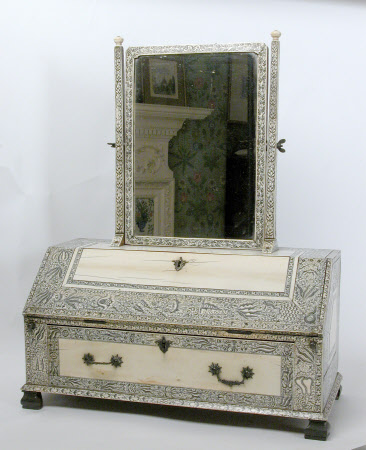Toilet mirror
Category
Mirrors
Date
1775 - 1800
Materials
Sandalwood (probably), ivory, silver and silvered glass
Measurements
67.5 x 53 x 25 cm
Place of origin
Visakhapatnam
Order this imageCollection
Wightwick Manor, West Midlands
NT 1288269
Summary
An ivory-veneered and engraved toilet mirror, or dressing glass, Visakhapatnam, late 18th century. The rectangular plate in a narrow frame between slender rectangular supports topped by turned ivory ball finials. The frame and uprights engraved with delicate leaves and vines. The box base fitted with a hinged fall enclosing an interior of pigeonholes and small drawers, all above a full-length drawer. Silver drawer handles and escutcheons.
Full description
This toilet mirror was made in the city of Visakhapatnam (Vizagapatam) in the state of Andhra Pradesh in India. A natural harbour with a thriving textile industry, it was also a centre for cabinet-making renowned for its use of ivory inlay and veneers. As European colonial activity in India increased over the first half of the 18th century, territorial wars and the struggle for dominance intensified, and Visakhapatnam was ruled by the Mughal Qutb Shahis (between 1689 and 1724), Nizam (1724–1757) and France (from 1757), before being captured by the British East India Company armies in 1765. This British colonial encroachment in India involved the looting and seizure of its material culture – art, precious objects and resources – but it is also affected local artistic production and a transfer of materials, techniques, knowledge and fashions which, rather like in Guangzhou (see Chinese Export furniture at Osterley, NT 771891, 773356 and 773362) and other trading ports, stimulated an export market in furniture specifically for European buyers. It is likely, therefore, that some of the furniture from Visakhapatnam now in English collections was legitimately purchased, although it should also be noted that it did feature among the ‘gifts’ exchanged between Indian rulers and Europeans. How this mirror came to be in the collections at Wightwick is unclear. In common with other examples judged to date from the end of the 18th century, it is entirely veneered in engraved ivory; earlier examples were made with more visible timber and inlaid with ivory, rather than veneered. Its form is English, but its decoration, and the flora it depicts, are quintessentially Indian.
Provenance
In 1937 Geoffrey Le Mesurier Mander gifted Wightwick Manor, its gardens and many of its contents to the National Trust. Geoffrey and his family continued to occupy and manage Wightwick, adding to the collection in collaboration with the National Trust. Sir Geoffrey died in 1962 but Lady Mander continued to live at Wightwick until her death in 1988. These collection items are listed in the Wightwick Manor 1937 inventory.
References
Jaffer 2001 : Amin Jaffer, Furniture from British India and Ceylon, a catalogue of the collection in the Victoria and Albert Museum and the Peabody Essex Museum, London, V&A publications, 2001. Jaffer 2002 : "Luxury goods from India, the art of the Indian cabinet maker", London, V&A publications, 2002.
